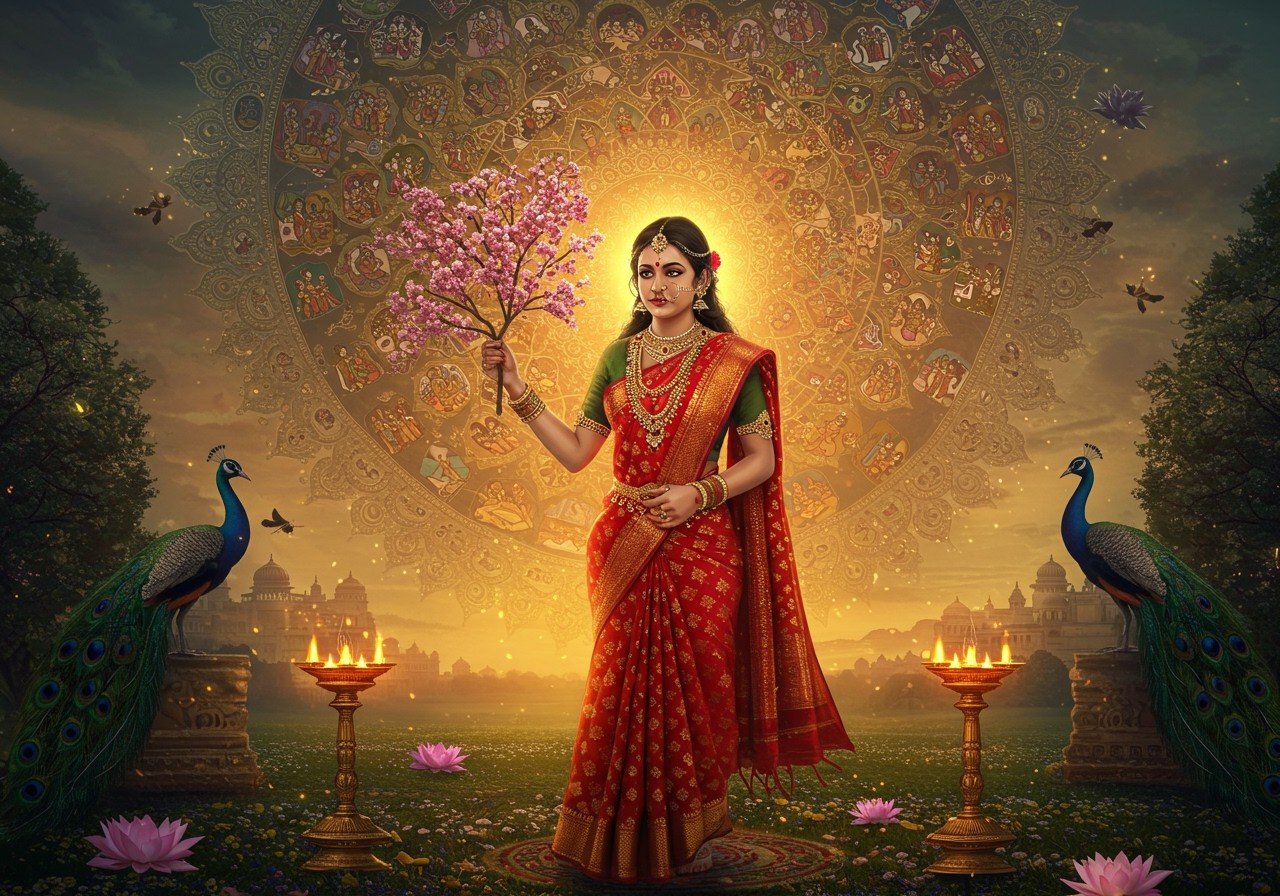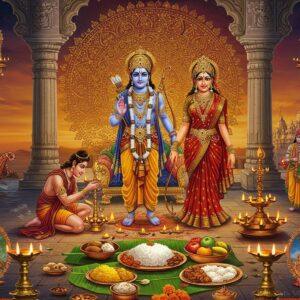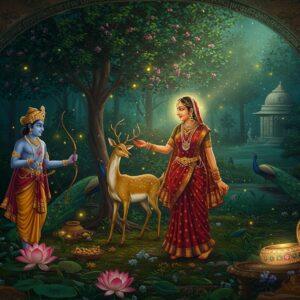
In the epic Ramayana, Sita stands as a central figure, embodying duty, devotion, and resilience. Her story, deeply rooted in Hindu mythology and culture, offers timeless lessons that continue to resonate today. Exploring Sita’s role provides a deeper understanding of traditional values and their significance in cultural practices. Poojn.in, India’s leading store for cultural and religious goods, offers a wide variety of products to enrich your understanding and celebration of these traditions. Discover how you can connect with Sita’s divine legacy through authentic puja items available on our platform.
Who is Sita in the Ramayana?
Sita is a pivotal character in the Ramayana, known as the adopted daughter of King Janaka of Mithila and the beloved wife of Lord Rama, the prince of Ayodhya. Their marriage marks a significant turning point, leading to Rama’s exile and a series of trials that test Sita’s unwavering loyalty and devotion. During their exile in the forest, Sita faces numerous challenges, culminating in her abduction by Ravana, the king of Lanka. Her captivity becomes a testament to her strength and unwavering faith. Ultimately, Sita’s rescue plays a crucial role in the narrative’s climax, marking her triumphant return to Ayodhya. Her journey is a powerful example of resilience, courage, and deep commitment.
Understanding the Meaning of Sita
The name “Sita” holds profound significance within the Ramayana and Hindu mythology. Derived from the Sanskrit word “sīta,” meaning “furrow,” it symbolizes her intimate connection to the Earth and agriculture. King Janaka’s discovery of Sita in a furrow during a yagna (a Vedic ritual) further emphasizes this association with agricultural fertility and establishes her as a daughter of the Earth. This unique birth story highlights Sita’s divine origin and foreshadows her enduring connection to nature’s abundance and nurturing qualities.
Symbolism and Virtues Embodied by Sita
Sita embodies a wealth of virtues, establishing her as a revered figure in Hindu tradition. She is considered the ideal woman, representing wifely virtue, devotion, courage, purity, and unwavering loyalty. As a devoted wife, she exemplifies the concept of ‘pativrata,’ showcasing unwavering loyalty to Rama, a principle that continues to guide many. As a representation of Shakti, the divine feminine cosmic energy, Sita complements Rama’s masculine energy, creating a harmonious balance that resonates throughout the epic.
- Ideal Womanhood: Sita’s character epitomizes wifely devotion, courage, and unwavering loyalty, setting a standard for ideal womanhood that transcends time. Her actions and choices throughout the epic reflect these virtues, inspiring generations to follow her example. Through trials and tribulations, Sita’s commitment to her principles shines brightly, illustrating the strength and grace of the ideal woman.
- Divine Feminine Energy (Shakti): Sita is a powerful representation of Shakti, the divine feminine cosmic energy, perfectly complementing Rama’s masculine energy. This duality creates a harmonious balance, essential for cosmic order. Sita’s strength, compassion, and resilience demonstrate the multifaceted nature of feminine power. She embodies the nurturing and life-giving aspects of Shakti while also showcasing unwavering resolve in the face of adversity.
Sita’s Connection to Earth and its Significance
As the daughter of Bhumi (the Earth), Sita embodies the planet’s fertility, abundance, and well-being. Her connection to the Earth goes beyond her birth story; it symbolizes resilience, nurturing qualities, and a deep respect for nature. This association offers valuable insights into the harmonious relationship between traditional values and the natural world. Sita’s story encourages us to embrace our connection with the earth and recognize its significance in our lives. Poojn.in offers a range of eco-friendly products for your puja needs, allowing you to honor this connection in your own practices. Explore our collection of sustainable and ethically sourced items here.
Sita’s Various Names and Their Significance
Sita is known by various names, each carrying its own significance and reflecting different facets of her character:
- Janaki/Janaknandini: These names emphasize Sita’s lineage as the daughter of King Janaka, highlighting her royal upbringing and the values instilled in her by her father. They signify her noble birth and the responsibilities that come with it. These names also connect her to the rich cultural heritage of Mithila, her birthplace.
- Maithili: This name identifies Sita as the princess of Mithila, connecting her to the land and its people. It highlights her role as a representative of her kingdom and the expectations placed upon her as royalty. This connection to Mithila also emphasizes her cultural identity and the traditions she embodies.
- Vaidehi: Derived from “Vaideh,” a name for King Janaka, Vaidehi signifies transcendence of body consciousness and spiritual depth. It suggests Sita’s inherent connection to the divine and her profound understanding of dharma. This name also means “the princess of Videha,” further reinforcing her royal status.
- Bhoomija/Bhusuta: These names reinforce Sita’s strong connection to Bhumi, the Earth goddess, emphasizing her earthly origin and her role as a symbol of fertility and abundance. They highlight her inherent connection to nature and her embodiment of its life-giving properties. These names also suggest her resilience and grounding in the face of adversity.
- Siya: A popular and affectionate diminutive used in local Hindi dialects, Siya reflects the widespread love and reverence for Sita among the common people. It signifies a sense of familiarity and endearment, further solidifying her place in the hearts of devotees. This name also speaks to the enduring legacy of the Ramayana within popular culture.
- Ayonija: This name signifies Sita’s miraculous birth, as she was not born from a womb but rather discovered in a furrow. It highlights her divine origin and sets her apart as a unique and extraordinary figure. It adds to the mystique surrounding her character and reinforces the idea of her being a chosen one.
These various names capture the multifaceted nature of Sita’s personality and her profound significance within Hindu culture. They provide a deeper understanding of her character and the multiple roles she plays in the epic narrative.
Sita as an Exemplar of Dharma
Sita stands as a powerful exemplar of dharma, or righteous conduct. Her actions throughout the Ramayana reflect her unwavering commitment to moral principles, providing guidance and inspiration for those facing adversity. She symbolizes resilience, endurance, and the importance of upholding one’s duty. Sita’s journey resonates with contemporary interpretations of womanhood and empowerment, offering timeless lessons in duty, devotion, and self-respect. Explore poojn.in’s collection of books and scriptures here to delve deeper into the teachings of the Ramayana and other sacred texts.
Connecting with Sita’s Divine Legacy through Poojn.in
Poojn.in provides authentic puja items that enable you to honor Sita Mata’s teachings and virtues in your daily worship. Our carefully curated selection supports your devotional practices related to Sita Mata and allows you to create a sacred space in your home. Visit www.poojn.in to explore our complete range of puja items. We ensure doorstep delivery of these sacred items across India, maintaining their purity and sanctity. Each product is carefully packaged and handled to preserve its religious significance.
Some relevant items for your Sita Mata puja include:
- Pure Cotton Sarees: Offer a beautiful saree to Sita Mata, symbolizing respect and devotion.
- Radha-Krishna Idols: Honor the divine couple, representing love and devotion, often associated with Sita-Ram.
- Brass Idols: Beautifully crafted brass idols of Sita Mata are ideal for your home altar.
Conclusion: Sita’s Enduring Legacy
Sita’s story transcends a simple tale of devotion and duty; it is a powerful narrative that continues to inspire and guide us. Her unwavering loyalty, courage, and profound connection to the Earth highlight virtues cherished across generations. As a symbol of Shakti, Sita embodies the balance between strength and compassion, teaching us the importance of inner resilience. By embodying dharma, she provides a blueprint for righteous living, inspiring us to embrace our values and navigate the complexities of modern life with integrity. Through Sita’s journey, we learn that true empowerment comes from within, guided by values as relevant today as they were in ancient times.


